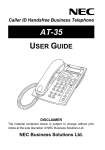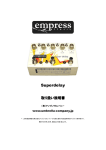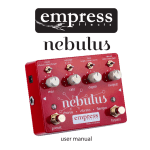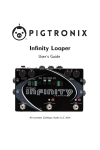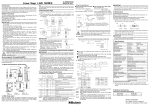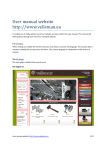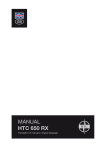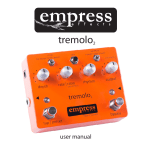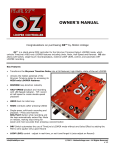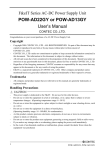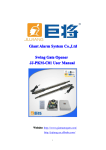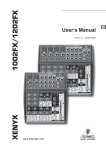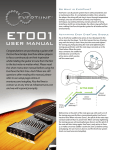Download superdelay
Transcript
superdelay user manual Introduction The Empress Effects Superdelay is the result of over 2 years of research, development and most importantly talking to guitarists. In designing the Superdelay, we strived to create a pedal with a comprehensive feature set and new innovative sounds in a compact package. We wanted to give guitarists a lot of control and ability to change sounds on the fly. The Superdelay offers a myriad of tap modes, the ability to save and recall multiple presets, support for an external expression pedal and much. We highly recommend that you peruse this manual and keep the ‘mode overview’ section handy as you explore and learn the features of the delay. To get the most out of this product we’ve put some brief instructional videos on our website: www.empresseffects.com Enjoy, Steve Bragg 1 Contents Introduction ........................................................................................................... 1 Quick Start ............................................................................................................. 3 Overview of Modes and Sub-modes ..................................................................... 4 The Modes in Detail............................................................................................... 5 Normal Mode .................................................................................................... 5 Tap Mode........................................................................................................... 6 Auto-Set Mode .................................................................................................. 7 Reverse Mode.................................................................................................... 8 Controls at a Glance ......................................................................................... 9-10 The Modes in Detail (continued) ......................................................................... 11 Rhythm (Multi-Tap) Mode ............................................................................... 11 Tape Mode....................................................................................................... 12 Misc Mode ....................................................................................................... 13 Looper Mode ................................................................................................... 14 Using Presets ....................................................................................................... 16 Expression Pedal .................................................................................................. 18 Specifications ....................................................................................................... 19 2 Quick Start Connect the supplied power adaptor to the Superdelay, plug in your guitar and connect the Superdelay to your amplifier. Set the controls on the Superdelay to the settings shown below. If the red bypass LED is not already lit, press the bypass switch to engage the Superdelay. You should hear a typical delay signal mixed with your guitar signal. You can move the knobs to suit your tastes, and change modes and sub-modes. 3 Overview of Modes and Sub-modes Normal Tap Auto-Set Reverse Rhythm Tape Misc Looper Description Sub-Mode A Sub-Mode B Sub-Mode C Normal delay sounds Short delay (5.5ms – 95ms ) Medium delay (45ms-800ms) Long delay (700ms-2.2s) Tap tempo delay. d time | ratio knob controls ratio . Ratios are 1:1, 1:2, 1:4. Delay time is the Triplet rhythm: delay same as the tapped time is 1/3 the tapped time. time. Delay time is set Low trigger automatically based on threshold for quiet the input. d time | ratio guitars or quiet knob controls ratio. playing. Dotted quarter rhythm: delay time is 1.5x the tapped time. Medium trigger threshold. High trigger threshold for loud guitars or loud playing. Delayed signal is reversed. d time | ratio knob controls ratio in sub-modes b and c. d time | ratio knob controls how long reversed segments of audio are. Length of reversed segments is set by tapping the tap switch. Reversed segments are played back an octave higher. Rhythmic repeats with up to four repeats entered by tapping. d time | ratio knob controls ratio and scale of pattern. d time | ratio knob scales the rhythm tapped. d time | ratio knob stretches or compresses the rhythm. First tap is quiet, taps get progressively louder. Analog tape delay emulation. tap switch sets the delay time. High quality tape compression artifacts added to delayed signal. Tape compression artifacts with a little bit of ‘wow and flutter’ added to the delayed signal. Tape compression artifacts with subtle intermittent dropouts akin to an older, shedding tape. Miscellaneous operation modes. Feedback increases as input volume decreases. Mix increases (more wet) as input volume decreases. Press tap switch to start/stop delay. Lets you trail off delayed signal. Record and loop audio clips. tap switch starts/stops recording. presets switch stops, clears existing loop. Normal looper mode. 6.8 seconds of loop time. Long looper mode. 13.6 seconds of loop time. Loop is played back in reverse. Audio layered after initial loop begins playback is played back forwards. 4 The Modes in Detail Normal Mode This is the standard digital delay type operation, known and loved by all. In Normal Mode the tap switch, when pressed, mutes the wet signal for one ‘delay time’ period. This is useful if you’re using a high feedback setting; you can press the tap switch when you change chords to avoid dissonance from the feedback of the previous chord ringing over the current chord. Sub-mode A – Short Delay In sub-mode A the d time | ratio knob varies the delay time between 5.5ms and 95ms. Sub-mode B – Medium Delay In sub-mode B the d time | ratio knob varies the delay time between 45ms and 800ms Sub-mode C – Long Delay In sub-mode C the d time | ratio knob varies the delay time between 700ms and 2.8 seconds. 5 Tap Mode In Tap Mode the delay time is controlled by tapping the tap switch repeatedly to a desired tempo. For tapped tempo accuracy the unit takes an average of repeated taps. In Tap Mode the d time | ratio knob acts as a ratio control in all sub-modes: If the knob is set between 7 o’clock and 10 o’clock it is a 1:4 ratio. The delay time will be four times as fast as the tempo tapped. If the knob is set between 10 o’clock and 2 o’clock it is a 1:2 ratio. The delay time will be twice as fast as the tempo tapped. If the knob is set between 2 o’clock and 5 o’clock it is a 1:1 ratio. The delay time will be the same as the tempo tapped. Sub-mode A – Normal Tap In sub-mode A the delay time is set to the tap time. Sub-mode B – Triplet Tap In sub-mode B the delay time is set to 1/3 of the tap time. If you tap quarter notes the delay time will be eighth note triplets. Note that the d time | ratio knob acts as a ratio knob in this mode. Sub-mode C – Dotted Tap In sub-mode C the delay time is set to 1.5 times the tap time. If you tap quarter notes the delay time will be set to dotted quarter notes. 6 Auto-Set Mode In Auto-Set Mode the Superdelay sets the delay time by listening to the dynamics in your playing. The Superdelay is watching for volume peaks in the input signal. For this to work effectively the input passages should have relatively consistent rhythmic content. When you start playing in Auto-Set mode you should see the large, yellow LED to the right of the tap switch blink with each note you strike. If it is blinking inconsistently adjust the threshold by changing the sub-mode (described in detail below). If you press the tap switch at this point, it changes the delay time in use to the last interval between peaks that it detected. Sub-mode A – Low Threshold In sub-mode A the threshold is quite low, allowing the Auto-Set Mode to identify the peaks in quiet passages or from instruments with quiet outputs. If you’re playing too loud for this mode, some single notes may be interpreted as two notes, causing the delay time to be too short. If the delay time is consistently too short, switch to a higher threshold. Sub-mode B – Medium Threshold In sub-mode B the threshold is medium allowing the Auto-Set Mode to identify the speed of the playing for instruments with average output levels, or parts of average loudness. Sub-Mode C – High Threshold Sub-mode C caters to louder instruments or passages. 7 Reverse Mode In Reverse Mode the delay samples are played backwards. Sub-mode A – Reverse Knob In sub-mode A the delay time is set with the d time | ratio knob. Maximum reverse delay time is 1.4 seconds. You will notice the yellow tempo LED is lit when entering this mode – this signifies that the input signal is being routed into the delay processor. When you press the tap switch the input signal stops being routed into the delay processor, but you will hear the trails of the delayed signal trail off. The yellow tempo LED will go dark letting you know that the signal is no longer being routed to the delay. This is similar to the behaviour of a gated delay. Sub-mode B – Tap Reverse In sub-mode B the delay time is controlled by pressing the tap switch repeatedly. The d time | ratio knob operates as a ratio in this sub-mode giving ratios of 1:1, 2:1 and 4:1. Maximum delay time is 1.4 seconds. Sub-mode C – Double Time Reverse In sub-mode C the delayed audio is played back in reverse, twice as fast as normal. This causes the audio to sound an octave higher. Maximum delay time is 933ms in this mode. Try turning the feedback up in this mode! 8 Controls a feedback : controls the delay feedback. Note the feedback ratio goes higher than one. This means if it is fully clockwise the sound will gradually get louder and louder. filter: adds a high pass (hp) or low pass (lp) filter to the delayed signal. EXPRESSION PEDAL exp pedal: when an expression pedal is plugged into the rear of the unit, this switch determines which parameter is controlled by the expression pedal. mix: controls the level between the dry signal and the wet, delayed signal. All the way clockwise is 100% wet signal and all the way counterclockwise is 100% dry signal. d time | ratio: in non-tap modes, this controls the delay time. In tap modes it controls the ratio of the delay time relative to the tempo that is tapped. For example, at 1:2, the delay time will be twice as fast as the tapped tempo. tap switch: in tap modes, this sets the delay time when tapped. It will change to the new delay time after 2 taps and will average the last 4 taps. - When cycling through the presets, tap to select a preset. - Also performs additional functions in normal, misc and looper modes. save switch: small, black button to the left of the presets switch. Holding the save switch and pressing the presets switch saves the current parameters to the selected preset bank. power: tip 2.1mm at a Glance modulation: applies modulation to the delayed signal. -the slow setting is a slower, more subtle modulation. -the fast position is a faster, slightly deeper modulation. + 9V -12V DC positive m jack. 300mA or greater OUTPUT INPUT mode specific switch: selects the sub-mode: a, b, or c. See the Overview of Modes and Sub-modes section for a detailed explanation of how the sub-modes work in each mode. volume: controls the overall output volume of the delay. mode: selects the different operation modes. norm- normal, d time knob controls delay time (p 5) tap- tap controls delay time (p 6) auto- autoset (p 7) rev- reverse delay (p 8) rhy- rhythm (p 11) tape- tape delay (p 12) misc- miscelaneous modes (p 13) loop- looper mode (p 14) bypass switch: when the LED is shining, the delay effect is applied to the signal. When off, the Superdelay is being bypassed (true bypass). presets switch: cycles through the stored presets, performs additional tasks in looper mode. Rhythm (Multi-Tap) Mode By pressing the tap switch repeatedly you can input a rhythm of up to four taps. This rhythm will be mimicked by the delay. Sub-mode A – Ratio In sub-mode A the d time | ratio knob acts as a ratio control. Depending where the d time | ratio knob points, the taps you’ve entered are played back at the speed at which they were tapped, or either 2 or 4 times faster. Sub-mode B – Scaling In sub-mode B the d time | ratio knob allows you to scale the rhythm you’ve entered. If you turn the d time | ratio knob clockwise after a rhythm has been entered, the rhythm will be stretched and made longer. If you turn the d time | ratio knob counter-clockwise, the rhythm will be compressed and made shorter. Note: If you stretch the rhythm to the point where one of the taps exceeds the 2.8 second maximum delay time, that tap will no longer be heard. Sub-mode C – Dynamic Volume Sub-mode C functions similar to sub-mode A with the exception that the volumes of the repeats are varied. The first repeat is fairly quiet, and the repeats get progressively louder. 11 Tape Mode Tape Mode was designed to impart some of the classic characteristics of analog tape delays. Delay time is controlled with the tap switch, and the d time | ratio knob functions as a ratio control in Tape Mode. Sub-mode A – Basic Tape Emulation Sub-mode A provides basic tape emulation. Tape saturation and compression artifacts are applied to the delayed signal. Sub-mode B – Vintage Tape Delay Sub-mode B adds a little bit of ‘wow’ and ‘flutter’ to the delayed signal; the kind you would associate with an older tape machine that has tape mechanisms needing replacement. This mode tends to impart the sound of a subtle chorus. Sub-mode C – Vintage Tape Delay with Old Tape Sub-mode C is similar to sub-mode B but with subtle, intermittent dropouts as one might experience from old, shedding tape and dirty heads. The repeated signal will also saturate more than normal. 12 Misc Mode Sub-mode A – Dynamic I: Feedback increases as input volume decreases. In sub-mode A, feedback increases up to the value where the feedback knob is set as the input signal gets quieter. During a loud passage the feedback will decrease to nearly zero. For example: If you have the feedback knob at 50%, when you play quietly or as notes ring out and sustain, the feedback will increase gradually to 50%. Sub-mode B – Dynamic II: Mix increases as input volume decreases In sub-mode B the mix increases (i.e. more wet) to the value where the mix knob is set as the input signal gets quieter. Conversely, the mix decreases (i.e. more dry) as the input signal gets louder. Sub-mode C – Tap Mute: Soft bypass with trails When playing, the output signal will be 100% dry until the tap switch is pressed once, after which you will start to hear the delayed signal. When you press the tap switch again the input signal stops being routed into the delay processor, but you will hear the tails of the delayed signal trail off. Sub-mode C is great if you only want delay in certain sections of the song but don’t want the delay signal to cut off abruptly when turning off the effect using the bypass switch. 13 Looper Mode The Empress Effects Superdelay is able to sample and loop 13.6 seconds of audio. Once an initial audio clip has been sampled it will loop continuously and the user can add additional layers to the loop. Sub-mode A – Normal Looper In sub-mode A the looper operates normally using the controls which are described in detail on the following page. You have 6.8 seconds of loop time available. Sub-mode B – Long Looper In sub-mode B the looper time is doubled to approximately 13.6 seconds. The quality of the recording is degraded slightly to CD quality samples in this sub-mode to allow for longer loop length. Sub-mode C – Reverse Looper In sub-mode C the initial loop is played back in reverse after it has been recorded. Any overdubs made will play back forwards. We’ve added the ability to switch from sub-mode B to sub-mode C while a loop is playing back. This gives you the ability to overdub new passages in reverse. You can record your loop in sub-mode B, switch to sub-mode C and the first overdub recorded will be looped back in reverse. Operating the Looper When the looper is first turned on, it is in the zero state. In this state it will pass the incoming signal without any effect. While in Looper Mode the feedback and d time | ratio knobs do not control anything. The mix knob controls the level between the sound that is looping and the sound that is played live. 14 Capturing a Loop Press the tap switch to begin recording a new loop. To stop recording press the tap switch again. The loop will instantly return to the beginning and start playing. This is referred to as the ‘looping state’. While the loop is playing, the incoming signal gets mixed with the looping audio so you’re able to play over top of the loop. If you try to capture a loop longer than the maximum looping time allowed, the looper will automatically start looping from the start of the captured loop. Adding a Layer to the Loop If the Superdelay is in the ‘looping state’ you can record additional layers on top of the loop. Pressing the tap switch commences overdub recording. Pressing it a second time stops overdub recording. The yellow tempo LED will be lit while the Superdelay is in overdub record mode. Clearing the Loop To reset the Superdelay back to the ‘zero state’ press the presets switch. Leaving Looper Mode To go to another preset from Looper Mode you must first tap the presets switch once to bring the Superdelay to the ‘zero state’. Press the presets switch a second time to enter Preset Mode and load a new preset. 15 Using Presets The Empress Effects Superdelay has 8 preset locations where users can store and recall their favourite settings. All the settings of each mode can be stored except for the audio loop in Looper Mode. When first powered up, the unit operates with the settings that are on the knobs, as opposed to a preset being automatically loaded. Preset Organization The 8 presets are represented by a series of LEDs located just below the knobs. Press the presets switch to scroll through the presets. When cycling through the presets, the small yellow LEDs below the knobs will turn on, from left to right, representing preset locations 1 through 4. Then, the small red LED below the mix knob will light and the small yellow LEDs will again turn on, from left to right, representing preset locations 5 through 8. When cycling through the presets you will notice that after preset 8, all the small LEDs will flash very quickly. This represents the ‘knob preset’ location. If you recall this preset the Superdelay will get its settings from the current knob and switch positions on the unit. In ‘knob preset’ no small LEDs will be lit. This is essentially going back to manual mode. Saving a Preset To save a preset, set the controls to the sound you would like to save. Then press the preset switch until you reach the preset location in which you would like to save. While the lights are flashing, press and hold the save button and then press the preset button. Your preset is now saved. 16 Recalling a Preset To recall a preset simply press the presets switch until the preset you’d like to recall is flashing, then press the tap switch to load the preset. The preset’s LED indicators should now be solid and bright. Changing a Preset If you change the position of a knob or switch after a preset is loaded, the preset’s LED indicators will dim to indicate that the preset has been modified, but not saved. If you move the knob or switch back to the position it was in when the preset was saved, the preset’s LED indicators will brighten again. This lets you find the positions of all the knobs and switches when the preset was saved. Once you have made your changes to the preset, you can save it in the current location by holding the save switch and then pressing the presets switch. The preset indicator LEDs should brighten to indicate the changes have been successfully saved. Factory Reset Presets To restore the Superdelay to its factory preset settings, do the following: 1. 2. 3. 4. Unplug the power and plug back in. When all the lights come on, press the tap switch. Quickly hold down the save button and press the presets switch. The lights should do a little jig confirming success. WARNING! This will overwrite your current presets and replace them with the factory presets. 17 Expression Pedal The Empress Effects Superdelay allows an external expression pedal to be used to control the various features on the fly. To access this capability plug an expression pedal into the exp pedal jack on the back of the Superdelay , and use the exp pedal switch to select which parameter you’d like to control with the pedal. You can select mix, or feedback. The expression pedal replaces the knob on the top of the unit. The Superdelay will work with most Tip-Ring-Sleeve (TRS) expression pedals. Any expression pedal used with the Superdelay should have: Tip – signal Ring – power Sleeve – ground The potentiometer in the pedal should measure approximately 10k Ohm. 18 Specifications Input Impedance: Output Impedance: Frequency Response (-3dB): Distortion: Noise: Input Voltage: Required Current: Power Input Connector: Height (enclosure only): Height (including controls): Length: Width: Weight: 1MΩ 1kΩ 20Hz – 16kHz 0.004% -101.5dB 9VDC-12VDC 300mA 2.1mm Barrel Connector 1.75” 2.25” 5.7” 3.75” 1.5lbs www.empresseffects.com 19




















